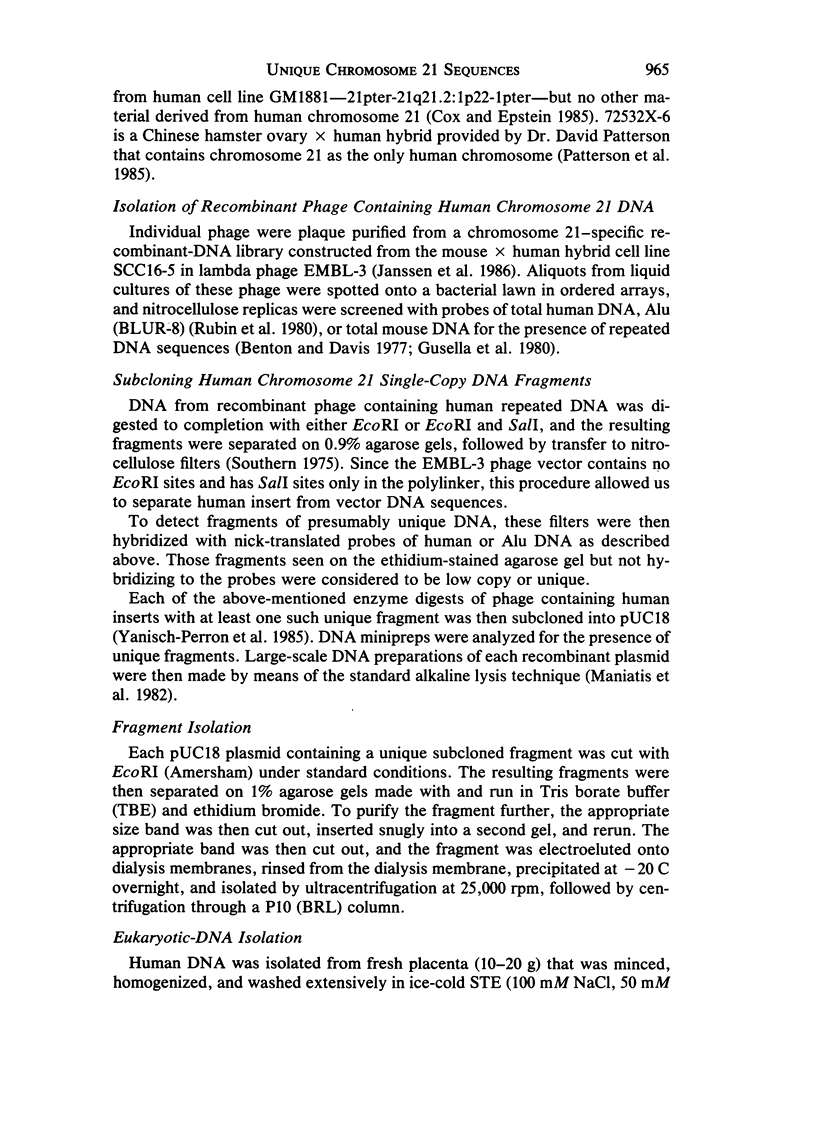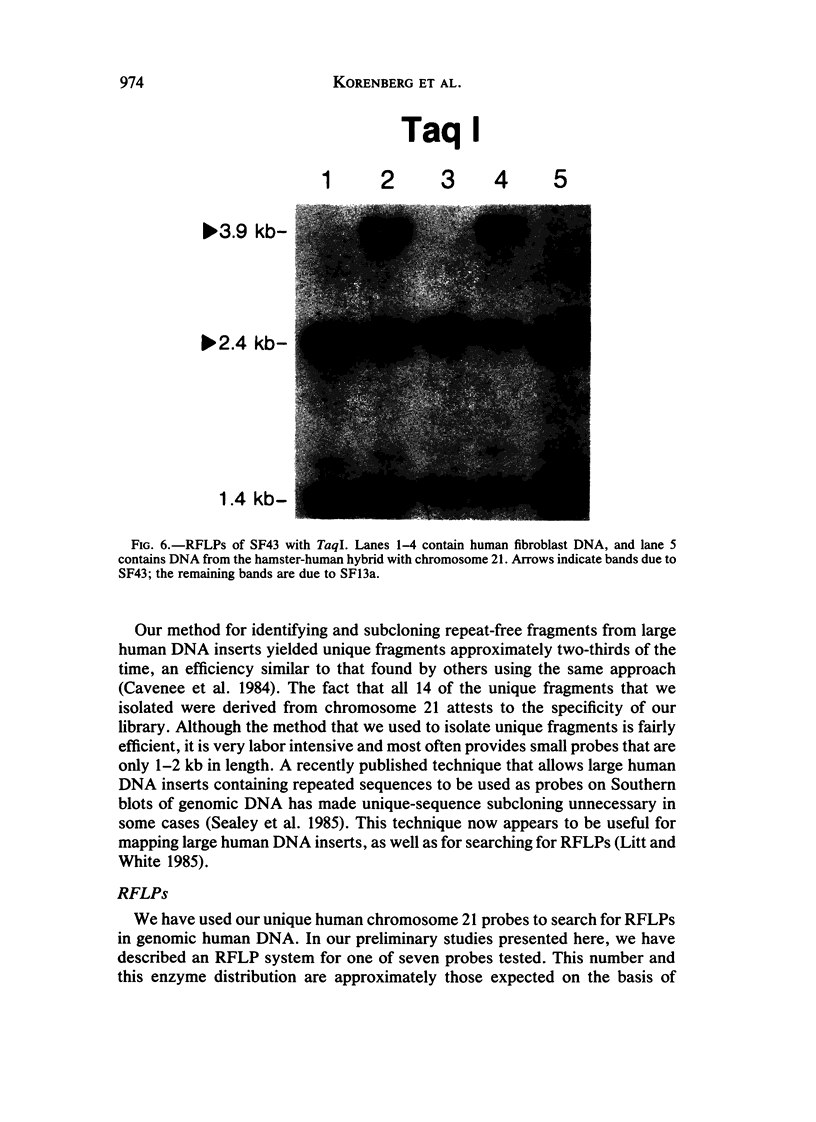Abstract
To isolate DNA sequences unique to chromosome 21 we have used a recombinant-DNA library, constructed from a mouse-human somatic-cell hybrid line containing chromosome 21 as the only human chromosome. Individual recombinant phage containing human DNA inserts were identified by their hybridization to total human DNA sequences and by their failure to hybridize to total mouse DNA sequences. A repeat-free human DNA fragment was then subcloned from each of 14 such recombinant phage. An independent somatic-cell hybrid was used to assign all 14 subcloned fragments to chromosome 21. Thirteen of the fragments have been regionally mapped using a somatic-cell hybrid containing a human 21 translocation chromosome. Two probes map proximal to the 21q21.2 translocation breakpoint, and 11 probes map distal to this breakpoint, placing them in the region 21q21.2-21q22. One of seven probes used to screen for restriction-fragment-length polymorphisms recognized polymorphic DNA fragments when hybridized to genomic DNA from unrelated individuals. These 14 unique probes provide useful tools for studying the structure and function of human chromosome 21 as well as for investigating the molecular biology of Down syndrome.
Full text
PDF















Images in this article
Selected References
These references are in PubMed. This may not be the complete list of references from this article.
- Aldridge J., Kunkel L., Bruns G., Tantravahi U., Lalande M., Brewster T., Moreau E., Wilson M., Bromley W., Roderick T. A strategy to reveal high-frequency RFLPs along the human X chromosome. Am J Hum Genet. 1984 May;36(3):546–564. [PMC free article] [PubMed] [Google Scholar]
- Antonarakis S. E., Kittur S. D., Metaxotou C., Bartsocas C., Kitsiou S., Watkins P. C., Patel A. S., Warren A. C., Gusella J. F., Groner Y. Linkage map on chromosome 21q and the association of a DNA haplotype with a propensity to nondisjunction and trisomy 21. Ann N Y Acad Sci. 1985;450:95–107. doi: 10.1111/j.1749-6632.1985.tb21486.x. [DOI] [PubMed] [Google Scholar]
- Benton W. D., Davis R. W. Screening lambdagt recombinant clones by hybridization to single plaques in situ. Science. 1977 Apr 8;196(4286):180–182. doi: 10.1126/science.322279. [DOI] [PubMed] [Google Scholar]
- Botstein D., White R. L., Skolnick M., Davis R. W. Construction of a genetic linkage map in man using restriction fragment length polymorphisms. Am J Hum Genet. 1980 May;32(3):314–331. [PMC free article] [PubMed] [Google Scholar]
- Brilliant M. H., Sueoka N., Chikaraishi D. M. Cloning of DNA corresponding to rare transcripts of rat brain: evidence of transcriptional and post-transcriptional control and of the existence of nonpolyadenylated transcripts. Mol Cell Biol. 1984 Oct;4(10):2187–2197. doi: 10.1128/mcb.4.10.2187. [DOI] [PMC free article] [PubMed] [Google Scholar]
- Brown W. T., Devine E. A., Nolin S. L., Houck G. E., Jr, Jenkins E. C. Localization of chromosome 21 probes by in situ hybridization. Ann N Y Acad Sci. 1985;450:69–83. doi: 10.1111/j.1749-6632.1985.tb21484.x. [DOI] [PubMed] [Google Scholar]
- Cavenee W., Leach R., Mohandas T., Pearson P., White R. Isolation and regional localization of DNA segments revealing polymorphic loci from human chromosome 13. Am J Hum Genet. 1984 Jan;36(1):10–24. [PMC free article] [PubMed] [Google Scholar]
- Church G. M., Gilbert W. Genomic sequencing. Proc Natl Acad Sci U S A. 1984 Apr;81(7):1991–1995. doi: 10.1073/pnas.81.7.1991. [DOI] [PMC free article] [PubMed] [Google Scholar]
- Cox D. R., Epstein C. J. Comparative gene mapping of human chromosome 21 and mouse chromosome 16. Ann N Y Acad Sci. 1985;450:169–177. doi: 10.1111/j.1749-6632.1985.tb21491.x. [DOI] [PubMed] [Google Scholar]
- Cox D. R., Smith S. A., Epstein L. B., Epstein C. J. Mouse trisomy 16 as an animal model of human trisomy 21 (Down syndrome): production of viable trisomy 16 diploid mouse chimeras. Dev Biol. 1984 Feb;101(2):416–424. doi: 10.1016/0012-1606(84)90156-8. [DOI] [PubMed] [Google Scholar]
- Davies K. E., Harper K., Bonthron D., Krumlauf R., Polkey A., Pembrey M. E., Williamson R. Use of a chromosome 21 cloned DNA probe for the analysis of non-disjunction in Down syndrome. Hum Genet. 1984;66(1):54–56. doi: 10.1007/BF00275186. [DOI] [PubMed] [Google Scholar]
- Feder J., Yen L., Wijsman E., Wang L., Wilkins L., Schroder J., Spurr N., Cann H., Blumenberg M., Cavalli-Sforza L. L. A systematic approach for detecting high-frequency restriction fragment length polymorphisms using large genomic probes. Am J Hum Genet. 1985 Jul;37(4):635–649. [PMC free article] [PubMed] [Google Scholar]
- Gusella J. F., Keys C., VarsanyiBreiner A., Kao F. T., Jones C., Puck T. T., Housman D. Isolation and localization of DNA segments from specific human chromosomes. Proc Natl Acad Sci U S A. 1980 May;77(5):2829–2833. doi: 10.1073/pnas.77.5.2829. [DOI] [PMC free article] [PubMed] [Google Scholar]
- Hagemeijer A., Smit E. M. Partial trisomy 21. Further evidence that trisomy of band 21q22 is essential for Down's phenotype. Hum Genet. 1977 Aug 31;38(1):15–23. doi: 10.1007/BF00295803. [DOI] [PubMed] [Google Scholar]
- Hassold T. J., Jacobs P. A. Trisomy in man. Annu Rev Genet. 1984;18:69–97. doi: 10.1146/annurev.ge.18.120184.000441. [DOI] [PubMed] [Google Scholar]
- Hassold T., Kumlin E., Takaesu N., Leppert M. Use of restriction fragment length polymorphisms to study the origin of human aneuploidy. Ann N Y Acad Sci. 1985;450:179–189. doi: 10.1111/j.1749-6632.1985.tb21492.x. [DOI] [PubMed] [Google Scholar]
- Hwu H. R., Roberts J. W., Davidson E. H., Britten R. J. Insertion and/or deletion of many repeated DNA sequences in human and higher ape evolution. Proc Natl Acad Sci U S A. 1986 Jun;83(11):3875–3879. doi: 10.1073/pnas.83.11.3875. [DOI] [PMC free article] [PubMed] [Google Scholar]
- Janssen J. W., Collard J. G., Tulp A., Cox D., Millington-Ward A., Pearson P. Construction and analysis of an EMBL-3 phage library containing partially digested human chromosome 21-specific DNA inserts (15-20 kb). Cytometry. 1986 Sep;7(5):411–417. doi: 10.1002/cyto.990070504. [DOI] [PubMed] [Google Scholar]
- Krumlauf R., Jeanpierre M., Young B. D. Construction and characterization of genomic libraries from specific human chromosomes. Proc Natl Acad Sci U S A. 1982 May;79(9):2971–2975. doi: 10.1073/pnas.79.9.2971. [DOI] [PMC free article] [PubMed] [Google Scholar]
- Litt M., White R. L. A highly polymorphic locus in human DNA revealed by cosmid-derived probes. Proc Natl Acad Sci U S A. 1985 Sep;82(18):6206–6210. doi: 10.1073/pnas.82.18.6206. [DOI] [PMC free article] [PubMed] [Google Scholar]
- Niebuhr E. Down's syndrome. The possibility of a pathogenetic segment on chromosome no. 21. Humangenetik. 1974 Jan 22;21(1):99–101. doi: 10.1007/BF00278575. [DOI] [PubMed] [Google Scholar]
- Patterson D., van Keuren M., Drabkin H., Watkins P., Gusella J., Scoggin C. Molecular analysis of chromosome 21 using somatic cell hybrids. Ann N Y Acad Sci. 1985;450:109–120. doi: 10.1111/j.1749-6632.1985.tb21487.x. [DOI] [PubMed] [Google Scholar]
- Rubin C. M., Houck C. M., Deininger P. L., Friedmann T., Schmid C. W. Partial nucleotide sequence of the 300-nucleotide interspersed repeated human DNA sequences. Nature. 1980 Mar 27;284(5754):372–374. doi: 10.1038/284372a0. [DOI] [PubMed] [Google Scholar]
- Sealey P. G., Whittaker P. A., Southern E. M. Removal of repeated sequences from hybridisation probes. Nucleic Acids Res. 1985 Mar 25;13(6):1905–1922. doi: 10.1093/nar/13.6.1905. [DOI] [PMC free article] [PubMed] [Google Scholar]
- Southern E. M. Detection of specific sequences among DNA fragments separated by gel electrophoresis. J Mol Biol. 1975 Nov 5;98(3):503–517. doi: 10.1016/s0022-2836(75)80083-0. [DOI] [PubMed] [Google Scholar]
- Stewart G. D., Harris P., Galt J., Ferguson-Smith M. A. Cloned DNA probes regionally mapped to human chromosome 21 and their use in determining the origin of nondisjunction. Nucleic Acids Res. 1985 Jun 11;13(11):4125–4132. doi: 10.1093/nar/13.11.4125. [DOI] [PMC free article] [PubMed] [Google Scholar]
- Tippett P., Kaplan J. C. Report of the Committee on the Genetic Constitution of Chromosomes 20, 21, and 22. Cytogenet Cell Genet. 1985;40(1-4):268–295. doi: 10.1159/000132177. [DOI] [PubMed] [Google Scholar]
- Van Keuren M. L., Watkins P. C., Drabkin H. A., Jabs E. W., Gusella J. F., Patterson D. Regional localization of DNA sequences on chromosome 21 using somatic cell hybrids. Am J Hum Genet. 1986 Jun;38(6):793–804. [PMC free article] [PubMed] [Google Scholar]
- Watkins P. C., Tanzi R. E., Gibbons K. T., Tricoli J. V., Landes G., Eddy R., Shows T. B., Gusella J. F. Isolation of polymorphic DNA segments from human chromosome 21. Nucleic Acids Res. 1985 Sep 11;13(17):6075–6088. doi: 10.1093/nar/13.17.6075. [DOI] [PMC free article] [PubMed] [Google Scholar]
- Willard H. F., Skolnick M. H., Pearson P. L., Mandel J. L. Report of the Committee on Human Gene Mapping by Recombinant DNA Techniques. Cytogenet Cell Genet. 1985;40(1-4):360–489. doi: 10.1159/000132180. [DOI] [PubMed] [Google Scholar]
- Yanisch-Perron C., Vieira J., Messing J. Improved M13 phage cloning vectors and host strains: nucleotide sequences of the M13mp18 and pUC19 vectors. Gene. 1985;33(1):103–119. doi: 10.1016/0378-1119(85)90120-9. [DOI] [PubMed] [Google Scholar]







